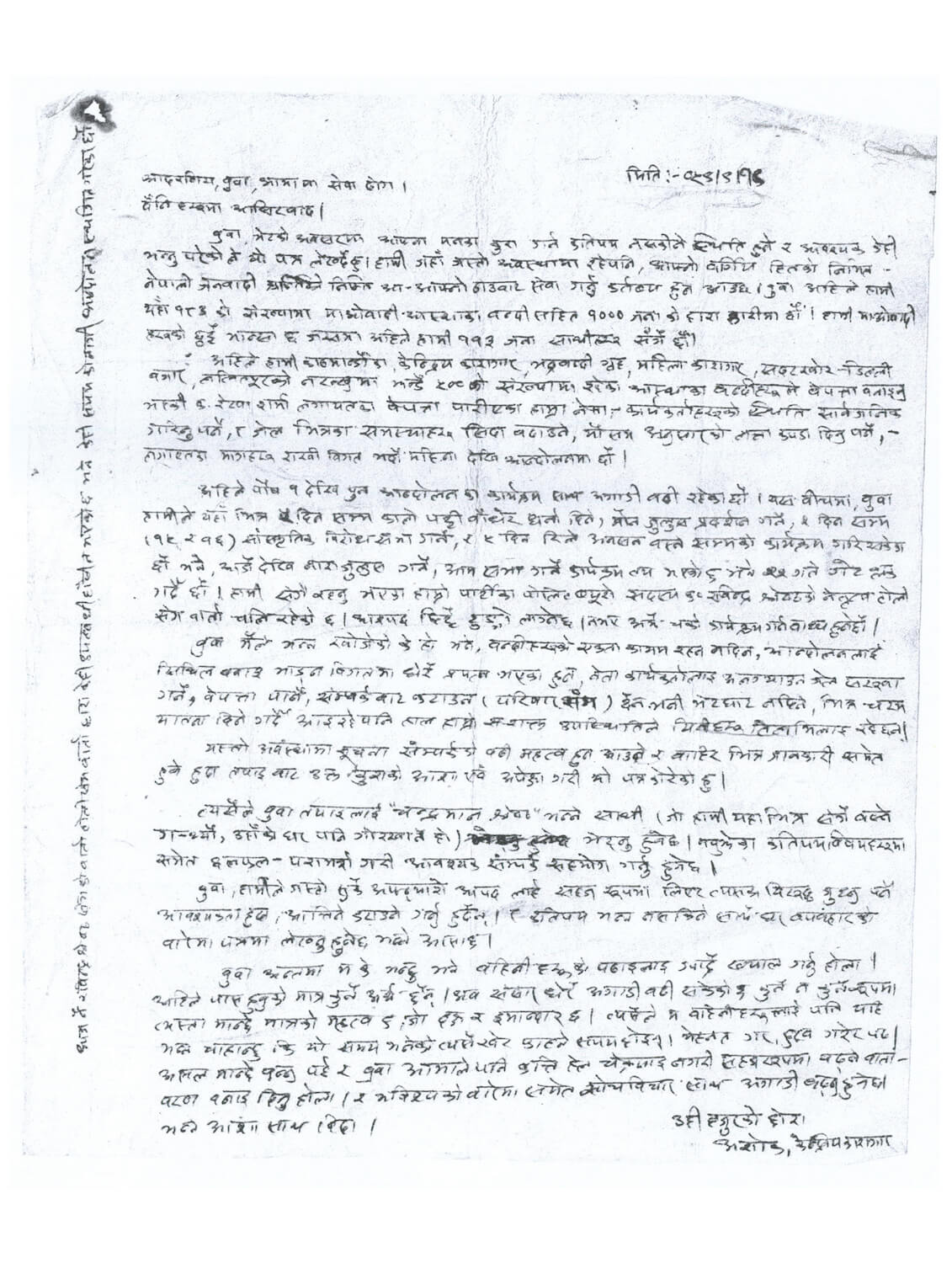Only memories remain
14 years and 11 prime ministers later
Text and photographs by Bikkil Sthapit
Many of the over 1,300 people still listed as missing after the Maoist war in Nepal left behind material objects. These are the only memories that remain, connecting the families to the loved ones who were disappeared.
These memorabilia from the decade-long war are the only substantial things that the family members have protected – 14 years after the conflict ended. They occupy a special place in the family homes and work places, preserving their presence. The objects also keep faint hopes alive that by some miracle, the family member will suddenly reappear one day.
More than 17,000 Nepalis were killed during the insurgency, there were brutal human rights violations and war crimes, including summary executions, disappearances, torture, rape, solitary confinement.
Since the end of the conflict in 2006, limited support has been provided to survivors and their families of the disappeared. However, there are no answers to questions like whether they are alive or dead, who killed them, why, where, when?
The Comprehensive Peace Accord (CPA) was signed on 21 November 2006 between the government of Nepal and the Maoist party. It brought ‘peace’ to a country weary of war, and propelled the former guerrillas to power.
However, 14 years and 11 prime ministers later, there have been no efforts to trace the missing, and tell families the truth, or give them justice. Two commissions were formed to investigate gross human rights violations and charge perpetrators, but neither have done much.
The discourse around transitional justice in Nepal has approached memory, truth and justice in legalistic terms so that the experience of acute loss of families is often lost. Missing are the personal accounts of survivors and families of victims.



When my brother, Ajaya Shahi, earned his first salary he bought this shirt. He was disappeared by the Army on 19 July, 2004. I have safely kept my brothers’ shirt in a separate box.
Bijaya Shahi
Kirtipur


My father used to make bronze Buddhas. Why is the army still not telling us what happened to him? Will this bring the peace to the country?
Nagma Mali
Daughter of Nanda Gopal Mali
Thecho, Lalitpur


My husband used to carry this sickle all the time in the rice field. It has been lying here ever since he was disappeared, and it is rusted. I have been keeping it safely as his last memento.
Ramkali Devi Tharu
Wife of Guru Prasad Kathariya
Rajapur, Bardia



My son used to recite from this Bible at church where we went together. I have kept this Bible thinking he will return some day. When that happens I will hand it over to him.
Ratna Kumari Mali
Mother of Baburaja Mali
Godavari, Lalitpur.

My son used the this plough whenever we went to the fields together. Today, we only have the plough. I cannot use it, and my son cannot use it.
Surjan Tharu
Bardia


He started to work for a pharmacy to manage the household expenses after his father died. This wall clock is the first thing he bought from his salary.
I keep looking at it to pass the time till my son returns home.
Mohan Maya Mali
Mother of Rajendra Mali
Godavari, Lalitpur.
During his 14-month-long jail time, my brother used to send us letters by hiding them inside biscuits and noodle packets. That's how we received this letter too. Butter Cracker and Wai Wai noodles still remind me of him. Even today, whenever I see biscuit and noodles, I anxiously think there might be a letter in it from him.
He was in touch with our family until 22 November, 2003. The last letter that we received was written from Sundhara Central Jail.
Sapana Suwarnakar
Sister of the disappeared Ashok Akela
Borlang-5, Gorkha


I was taken to Bhairabnath Batallion on 12 December, 2004. I was wearing this sweater when the army freed me and dropped me off at Banasthali Chok on February 17, 2005. Swatantra Chaulagain of Bhote Chaur, Sindhupalchok, had given me this sweater while we were in the army camp together. “Please register my name at Amnesty. Don’t quit the party if you return safely,” he had told me.
Swatantra Chaulagain is still missing.
Ujjwal Acharya (name changed)
Kavre
Bikkil Sthapit is a rights activist and a photographer who has been documenting the issue of enforced disappearances in Nepal. He also runs the oral history initiative SunaMeroKatha.com
These profiles were prepared during the Memory, Truth & Justice project of VOW Media.
------------------------------------------------------------------------------------------------------------------------------------------------
“We went everywhere, but we got no answers”
Text and photographs by Sabrina Dangol



Ram Maya Nakarmi, 44, is packing up all her belongings as she prepares to move her residence again. She has been renting a one-bedroom flat with her only daughter, Lumana Nakarmi.
It will be the fourth time she moves homes in the last five years, after the 2015 earthquake destroyed her old house, the same one where her husband, Padam Narayan Nakarmi, was forcefully taken away in 2003.
Padam Narayan used to work as an ironmonger in a small grill shop in Bungmati. They had been married for five years, and Ram Maya knew that he had been in touch with the Maoist party off and on.
"Deep down I knew it was coming," she says, remembering that eight of his friends had got arrested a few days earlier.
When they came for him, it all happened so fast that she only remembers pleading with the security personnel to let her accompany him to the police station. They refused, but assured her he would return the next day. It has been 17 years, and she never saw her husband again.
"When they came for Padam, they climbed into our room through a ladder. They didn't even knock or give us a time to decide anything,” Ram Maya recalls. “If I had known back then, I would have locked all the doors and windows shut."
 Ram Maya retrieving her husband’s picture from her purse.
Ram Maya retrieving her husband’s picture from her purse. Ram Maya’s reflection caught in the mirror.
Ram Maya’s reflection caught in the mirror.

In the months following her husband’s arrest, Ram Maya went to police stations almost every day, walking up to 10km into town and back. Buses were scarce and the fare was expensive. Some of his friends were freed and told her that they had all been together in Bhairabnath Battalion base in Maharajganj for months.
Later, Padam Narayan had been separated and taken somewhere else. So, Ram Maya visited Bhairabnath and the army base in Lagankhel regularly for two years.
Her daughter Lumana, who was four years old, kept asking for her father. So she took her small child with her to Maharajganj and pleaded with the authorities to at least let her daughter see her father, but they did not allow her.
Ram Maya was told to go to the Royal Nepal Army headquarters, and she kept going there, but no one wanted to tell her anything.
"I am not literate. I don't have people skills, nor can I present an argument properly. My brother-in-law helped me and accompanied me everywhere, but it was of no use. We got no answers," she recalls.


Ram Maya's in-laws supported her for the first two years of her search, but they also lost hope. Her daughter also stopped asking about her father, and stopped even mentioning him.
She got a factory job in Bungamati and focused on raising her daughter, who is now 20, studying and working at the same time. Neither mother nor daughter likes to remember those dark days any more.
Ram Maya says, "We somehow survived amidst all the chaos and grief, but it feels like a part of both of our lives have been lost. I say that I have given up, but deep down I still hope for his return.”
More on series of features for the International Day of Disappeared:
The empty chairs, Guligo Jia
Disapperance of justice, Sabrina Dangol




